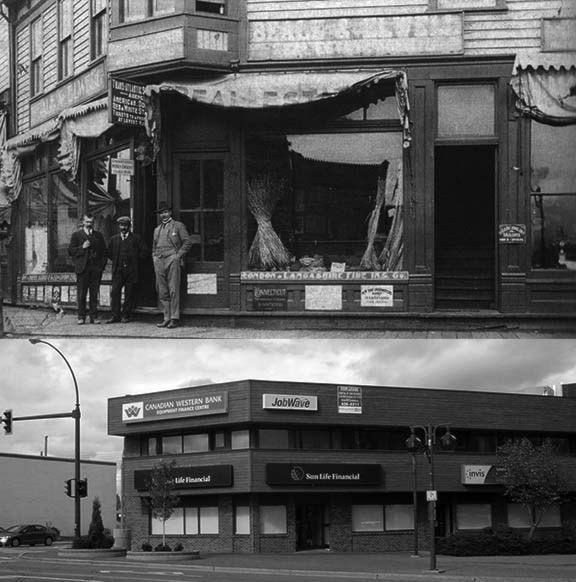Jim Cameron
South View, Sunnyside, Fairview, Mountainview, Buena Vista Gardens — by the 1920s, if you weren't living in "Old Cranbrook" you were likely in one of the aforementioned subdivisions. They're still there but the names have been lost; they're now just 4th Street or 5th Avenue or other such byways. Turns out that no matter what spin the real estate people put on the project, we're all just living in Cranbrook.
In April 1898, Cranbrook was, according to one pioneer, about 35 people and a big yellow dog. Within one year it was a town of some substance. The men who sold the land to the people who hired the contractors to build the buildings earned very good profits. In that regard things have changed very little.
Originally it was V. Hyde Baker and the CPR, selling real estate from the townsite office. Within a short time, however, it was independent sellers wheeling and dealing. The firm of McVittie and Hutchison were the first, working hard to spread the name of Cranbrook throughout the land and spread the land throughout the people. By the time they dissolved their partnership in November 1900, the town of Cranbrook as we know it was beginning to take shape, with one-and-a-half blocks along Baker Street, 40 or so homes on Baker Hill and numerous houses scattered about the flatlands.
A local Building and Loan Association attempted to ensure that deeds were honoured and policed; a tricky job at times with buildings going up helter-skelter and con men working the field — more than one property owner discovered too late that the land they paid for wasn't legally theirs.
Mistakes cost money, as in the case of the Forrest Hotel (later the Wentworth cum Allan) on Baker Street, which was well under construction when it was discovered that part of it was on the wrong lot. Rather than start again, Mr. Forrest paid dearly to purchase the extra property.
An average lot might cost anywhere from $100 to $1,000 depending on the location. Houses ranged from small $200 cottages to expansive $2,500 residences ($69,700 in today's standards according to the Consumer Price Index). A furnished restaurant sold for $900 and a brick bake oven (go figure) with house and stable on a single lot sold for $360. It was all a question of priorities.
The number of cottages near the CPR — many of them still standing — grew in direct proportion to the CPR rail yards and the number of men employed. Baker Street merchants and businessmen gradually moved from their original quarters in their places of business to houses befitting their position in local society, further increasing the residential section.
As Cranbrook continued to grow so did the surrounding district. Farms and dairies sprang up all around the town in areas that are now well within city limits. In 1902, Hyde Baker divided a great deal of land along the Kootenay River into 40-acre lots to meet the demands of small ranchers.
During the summer of 1902, the initial building boom was effectively over, although the town continued to grow with two or more lots sold each week for much of the year, numerous houses erected and families waiting in line for vacancies. By 1903, most of the Baker Hill roads were cleared and even the most unpretentious cottage rented for up to $25 per month (approximately $673 by today's CPI). That same year the assessed value of Cranbrook realty and personal property was half a million dollars, and would double by 1905. The realtor population increased accordingly, most notably with the additions of J.A. Arnold and T.M. Roberts, who not only dealt in land, loans and insurance but also sold Singer sewing machines. Mr. Roberts would later serve as mayor for 16 years, not the only civic leader to move from local real estate to politics.
The firm of Beale and Elwell came upon the scene in the early 1900s and would continue as one of the city's premier real estate agencies until 1943, when the holdings of both themselves and T.M. Roberts were purchased by Jack Falkins. Falkins Insurance Group remains in business today, perhaps the oldest continuous business in Cranbrook.
The years between 1909 and 1914 would see subdivisions bought and sold. South View (4th Street between 7th and 11th Avenue) was among the first, with the Wardman Addition (an extension of 5th Avenue past 2nd Street) and the Horie Addition (the south west area beyond 2nd Street) following close at hand. Numerous enticingly named areas rose up and became a part of the city fabric.
Occasionally, however, the realtors would neglect to properly name a subdivision. A letter to the newspaper in July 1927, reads, "We the undersigned are desirous of having an official name for the eastern residential section of the City of Cranbrook, known at present as 'Across the Creek.' Therefore, we as citizens of said district, propose the name of Baker Heights. We beg you will give this your favourable consideration, and ask that an Official notice will be put in the local paper to that effect for at least three successive weeks, that it may be known and recognized."
The letter was signed by 27 of the prominent and well-respected residents of the area. Did it work? Nope. The subdivision is still there however, on 15th and 16th Avenue – you know, just this side of Baker Park, across the creek.
